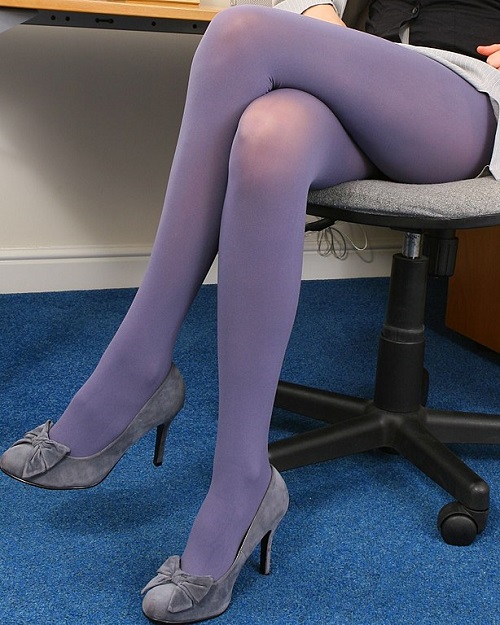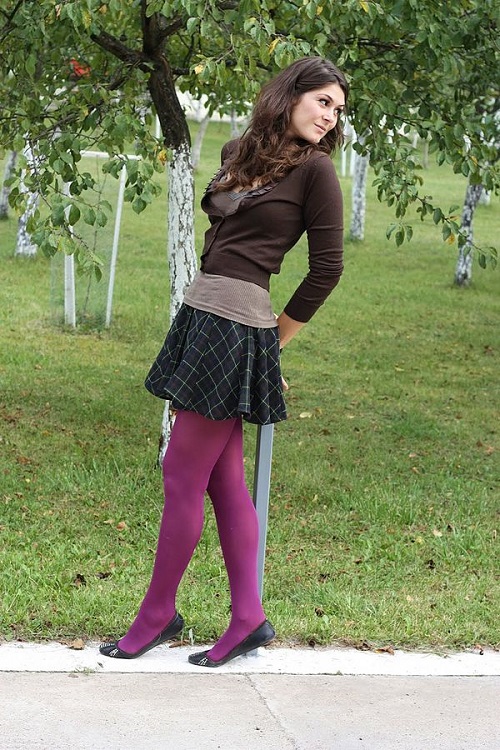Difference Between Pantyhose and Tights

Pantyhose
Pantyhose vs. Tights
Pantyhose and tights are two kinds of leg garments. Both garments are coverings that start from the wearer’s waist down to the feet. These garments cover the lower body parts, like the thighs and the legs. Many people prefer wearing both garments because they are comfortable, close fitting, but stretchable.
An important similarity between tights and pantyhose is their usage. Both garments provide warmth and beauty. Wearing these garments and prevent skin chafing at the foot and hide skin imperfections like skin color, blemishes, bruises, hair, scars, varicose veins, and other things to help beautify a woman’s legs. Both also provide a uniform shape and color of the wearer’s legs.
However, there are also many differences that exist between the two garments. The first difference is in language use.
In America, the word “pantyhose” refers to sheer garments that are worn as hosiery. Pantyhose are a successor and replacement of stockings. Tights, in the American perspective, refer to a similar garment with denser, opaque, and thicker material. Pantyhose can range from 8 to 30 denier (the measurement used to denote thickness or thinness of fabric). Tights, on the other hand, are 40 to 100 denier.
Meanwhile, the British and some Europeans do not have pantyhose. Rather, they only have tights, which refer to the same leg wear design and construction. In this context, tights are a general term that encompasses both thin and thick legwear.

Tights
Another difference is in the nature of the garment. Pantyhose are almost considered as an undergarment or underwear. As hosiery or underwear, pantyhose cannot be worn on their own but serve as a supplementary garment in adherence to a certain dress code in a particular situation or context. On the other hand, tights can be worn independently as legwear.
As an underwear or hosiery, pantyhose are sheer, almost see-through, and skin revealing. This is because pantyhose are made as a thin material in the leg section. However, the panty or upper part of the pantyhose is often made with cotton or other porous material. In contrast, tights have a uniform consistency of fabric.
In use, pantyhose are utilized as lingerie and on formal occasions. They is prone to tears (often called runs), while tights are more durable and used in casual, performance, utility, and athletic events.
The origins of pantyhose and tights also differ. Pantyhose were introduced in 1959; meanwhile, tights were have been in existence since the Medieval Ages. Pantyhose are exclusive to women, while both sexes can wear tights.
Summary:
1. Both pantyhose and tights are leg garments. However, they have significant differences.
2. Pantyhose and tights as garments are used in the U.S. The word “pantyhose” refers to the sheer, undergarment legwear, while the word “tights” refers to opaque and thicker legwear. In England and some European countries, tights are a general garment term for any legwear regardless of thickness or thinness.
3. Denier count on pantyhose ranges from 8 to 30, while tights have the denier count of 40 to 100. The thinness of the pantyhose contributes to their vulnerability to tearing, while the thickness of the tights indicates their durability.
4. Pantyhose are used as an undergarment, lingerie, or a staple in a formal women’s wardrobe. On the other hand, tights are durable, made for a variety of purposes (athletic, performance, casual, or utility), and can be worn by both sexes.
5. The construction of pantyhose requires different combinations of material. The upper part, which serves as underwear, is made of porous material and gets slightly thinner as it reaches the bottom. Meanwhile, tights have a consistent thickness of fabric or material throughout the garment.
6. Tights were made and worn earlier than pantyhose. They have been in fashion since the Middle Ages and still exist to this day. Pantyhose, on the other hand, are considered newer, with their introduction in 1959.
- Differences Between Fraternity And Sorority - January 8, 2014
- Differences Between Lucite and Plastic - January 7, 2014
- Differences Between Oil and Butter - January 6, 2014
Search DifferenceBetween.net :
7 Comments
Leave a Response
References :
[0]https://commons.wikimedia.org/wiki/File:Pantyhosefashion3.jpg
[1]https://en.wikipedia.org/wiki/Tights

This article is somewhat misldeading: there are multiple kinds of tights, some of which meet the description above, but others of which do not.
With respect to modern, general-population fashion terminology, tights are essentially just thicker pantyhose (i.e. higher denier pantyhose, as mentioned in the article). There are control-top tights (i.e. non-uniform consistency of the material), and tights, although having a higher denier, are still not heavy enough to be able to be worn as pants substitutes on their own (unless you’re really brave!).
Tights are not to be confused with leggings, which are very thick, footless garments that can be worn on their own.
Some leggings are thin like tights and shouldn’t be worn the same as pants.
Difference between depends where you live in England all legwear are called tights in the USA we call tights as a high denier ,pantyhose is of a lesser denier and then there are leggings just a footless type.
In the UK (where I’m from) most of this is all wrong from what I see there just the same and most of the stuff in here are lies.
I would just like to say that tights most certainly were not used in the middle ages outside of Hollywood productions. Men in the middle ages wore hose, which were at first sewn stockings, and later (for a while) were joined at the hip to form very body-hugging leggings, but they were still sewn from woven fabric and not from elastic knitted materials. Knitted stockings were introduced during the Renaissance, but the garment we call ‘tights’ today (elastic, form-hugging coverings from waist to feet) are a modern invention.
Also, I would definitely never wear tights, regardless of thickness, as the sole leg covering. They require a skirt or dress, or even shorts, worn over them.
There is no reason why men cannot wear pantyhose. They are mostly marketed to women but you can get sheer styles for men nowadays. Hosiery of all styles is unisex in the 21st century!
I believe tights can be worn by both men and women to keep your legs warm.